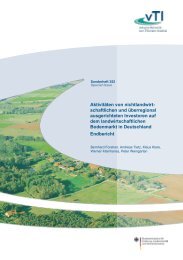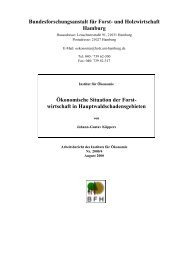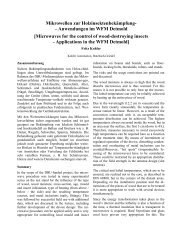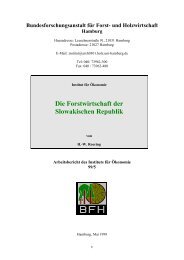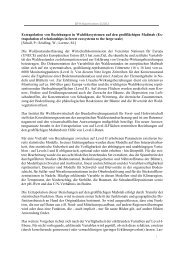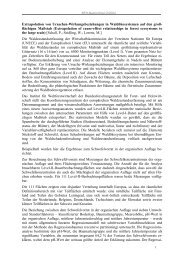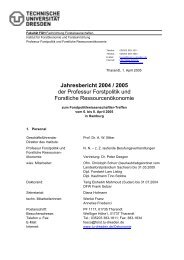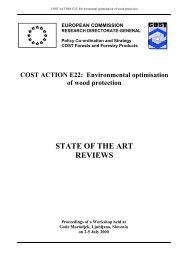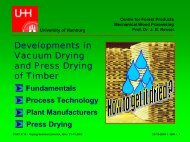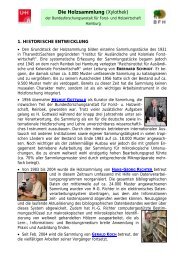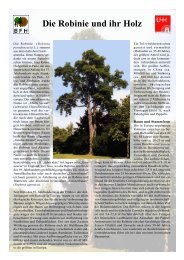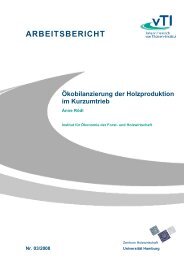Vegetative Propagation of Cupressus sempervirens
Vegetative Propagation of Cupressus sempervirens
Vegetative Propagation of Cupressus sempervirens
You also want an ePaper? Increase the reach of your titles
YUMPU automatically turns print PDFs into web optimized ePapers that Google loves.
genotypes exhibited significantly higher rooting rates during<br />
the winter, and for 2 <strong>of</strong> them (G4, G7) the difference was highly<br />
significant (Figure 1). Significantly higher rooting during the<br />
winter was present for all treatments (Table 4).<br />
The analysis <strong>of</strong> variance revealed the presence <strong>of</strong><br />
season x genotype interaction (Pr > F = 0.0129). Genotype 4<br />
which had shown highest rooting rate during the winter, did<br />
not give any rooted cuttings in spring. On the other hand, G7<br />
and G11 rooted well during both seasons.<br />
The percentages <strong>of</strong> callus for the whole cutting material in<br />
the 2 seasons were significantly different, being higher during<br />
the winter (Pr > |Z| = 0.006). However, at treatment and<br />
genotype levels, the season did not seem to influence the<br />
formation <strong>of</strong> calli (Table 5 and Figure 2).<br />
NS Z > 0.05; *Z < 0.05; **Z < 0.01; ***Z < 0.001<br />
Figure 2. – Differences in the callus percentages between the winter<br />
and spring cutting collections at genotype level (Experiments 1 and 2).<br />
Preliminary hedging<br />
The cuttings from nonhedged donors were obtained from the<br />
lower part <strong>of</strong> the crown. Under the shadow <strong>of</strong> the upper crown<br />
and the neighbouring trees the shoots were not growing<br />
intensively and had dark-green leaves. The hedged ortets were<br />
exposed to full sunlight, exhibiting fast growing, light-green,<br />
succulent shoots.<br />
The statistical test showed significant difference in the<br />
rooting (Pr > |Z| = 0.0003) and callus formation (Pr > |Z| =<br />
0.0079) between the cuttings from hedged and nonhedged<br />
donors. The propagation material from the nonhedged ortets<br />
resulted in 15.87% <strong>of</strong> rooted cuttings, while that from the<br />
hedged ortets only in 1.85%.<br />
The nontreated cuttings from both categories donor plants<br />
rooted poorly and their rooting percentage did not differ<br />
significantly (Table 8). The auxin treated cuttings had<br />
significantly higher rooting rates when obtained from<br />
nonhedged ortets and only the cuttings from hedged donors<br />
treated with the higher auxin concentration showed some<br />
rooting (Table 8). Only the 2000 ppm IBA treated cuttings from<br />
nonhedged ortets formed a significantly higher number <strong>of</strong> calli<br />
in comparison with the other category (Table 8).<br />
Table 8. – Percentages <strong>of</strong> rooting and callus by treatments for hedged<br />
and nonhedged donors.<br />
1 – Wilcoxon rank-sum test for the variable hedging.<br />
ns = Z > 0.05; * = Z ≤ 0.05; ** = Z ≤ 0.01; *** = Z ≤ 0.001<br />
Discussion<br />
Duration <strong>of</strong> rooting period<br />
The periods usually used for rooting <strong>of</strong> <strong>Cupressus</strong><br />
<strong>sempervirens</strong> cuttings are 3 (PANETSOS, 1993) to 4 months<br />
(CAPUANA and LAMBARDI, 1994). However, no experiments have<br />
been conducted to study the optimal duration <strong>of</strong> rooting<br />
required for this species. Some research work on this subject<br />
has been done for Chamaecyparis selected cultivars (OSIECKA,<br />
1991). The experiment by JORDANOV (1992), who obtained up to<br />
60% rooting <strong>of</strong> <strong>Cupressus</strong> <strong>sempervirens</strong> cuttings from 15 year<br />
old donor plants, keeping them in the rooting bed for 220 days,<br />
suggested that the duration <strong>of</strong> the rooting period could be <strong>of</strong><br />
key importance for the species. Although the first experiment<br />
did not aim to study this problem in detail, it proved that the<br />
extension <strong>of</strong> the rooting period by one month could give 40%<br />
more rooted cuttings, which is a very high number for the<br />
difficult-to-root species such as <strong>Cupressus</strong> <strong>sempervirens</strong>. It<br />
could be noticed that the non-treated cuttings demonstrated a<br />
remarkable increase in rooting during the fourth month, which<br />
can be ascribed to delayed expression <strong>of</strong> the potential (inherited)<br />
genotype rootability. The results agree with the conclusions<br />
by JOHNSEN (1986) and OSIECKA (1991) that the effect <strong>of</strong> the<br />
root-promoting substances on final rooting is particularly<br />
pronounced when rooting period is short, since their action is<br />
primarily in the acceleration <strong>of</strong> rooting. In the present study<br />
this was especially the case with the lower hormone concentration<br />
(2000 ppm), while the higher (4000 ppm) showed a more<br />
prolonged effect.<br />
All the genotypes showed an increase in rooting during the<br />
fourth month and may be <strong>of</strong> interest for future experiments.<br />
However, they could be classified in several categories<br />
according to the results obtained by the end <strong>of</strong> the fourth<br />
month. The well rooting genotypes (G1, G4, G6, G7) for which<br />
the pr<strong>of</strong>it from prolongation <strong>of</strong> the rooting period by one month<br />
is questionable, constitute the first category. The second<br />
category contains genotypes that rooted satisfactorily during<br />
the first 3 months and showed increase during the extension<br />
period. The genotypes that rooted poorly during the 3-month<br />
period and exhibited pronounced increase during the fourth<br />
month, constitute the third category. The poorly rooted<br />
genotypes, which were indifferent to time are classified in the<br />
fourth category. For the first category it could be recommended<br />
a new experiment limited to the time periods already<br />
examined, be aimed at evaluating the potential amount <strong>of</strong><br />
rooting increase. The second and third categories require trials<br />
with more prolonged time for rooting, while with the fourth<br />
category should try higher auxin concentrations and<br />
treatment-time combinations.<br />
Along with the quantitative change for time, a qualitative<br />
change was also noticed in some genotypes. In this sense, the<br />
genotypes could be divided into 2 main groups: 1) genotypes<br />
which showed time x treatment interaction and 2) genotypes<br />
which did not. Those genotypes that exhibited time x treatment<br />
interaction were unpredictable, especially in the cases<br />
when all the treatments showed some increase <strong>of</strong> the rooting<br />
percentage during the extension period. In this case, it could be<br />
recommended that the rooting period in the new experiments<br />
be extended, and the percentage <strong>of</strong> rooting for each treatment<br />
should be evaluated at 2 to 3 week periods (OSIECKA, 1991). It<br />
would also be useful to evaluate the potential anticipated<br />
increase by examining a higher number <strong>of</strong> cuttings, especially<br />
for the well rooting genotypes. Some <strong>of</strong> the genotypes (G5, G9,<br />
G11, G13, G14) were consistent, regardless <strong>of</strong> time and<br />
developed maximum rooting at 2000 ppm IBA treatment.<br />
Genotype G10 showed rooting percentages proportional to the<br />
141



